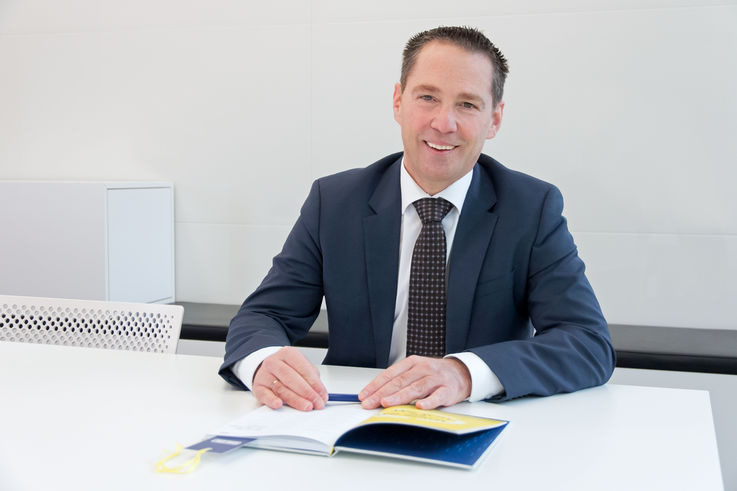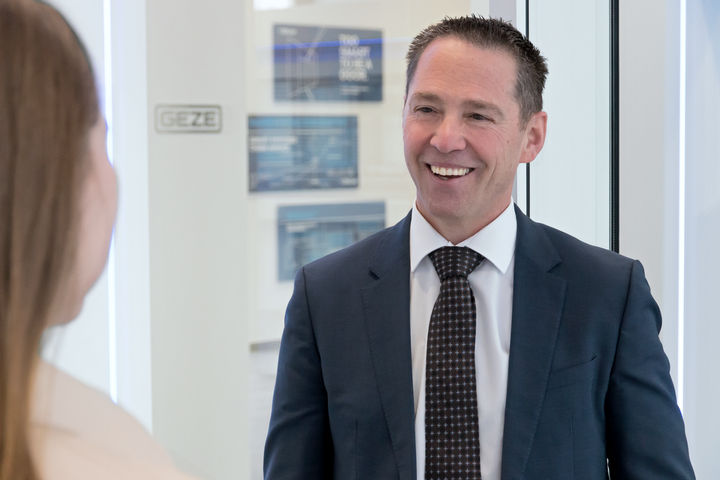GEZE networks on all levels
Gerald Haas has been Managing Director Research & Development at GEZE since 2017. In an interview, he discusses what makes a GEZE product, what he perceives networking to be, and how the business promotes its digitalisation strategy and continued development of GEZE Cockpit.

Gerald Haas and his team develop sophisticated products for complex requirements. © GEZE GmbH
Mr Haas, you have been responsible for the development department at GEZE for almost three years now. How has the market developed during this time?
In general: doors, windows and buildings are becoming more and more complex. And demands for every door and window have increased enormously. These days, doors and windows have to be planned and constructed in a multi-functional way: accessibility, fire protection, escape and rescue routes, smoke extraction or even natural ventilation are only a few of the keywords which serve to illustrate this complexity. And as well as construction demands, there are also customer demands for sound protection, convenience and design. However, it is clear that the building safety aspect must always take top priority. Our task is to guarantee this safety while also taking certain demands in all concerns and configurations into account, which can often contradict each other.
And how do you do that?
Our method involves bringing systems together. For us, it is about turning buildings into real ‘smart buildings’, especially large buildings, because the complex connectivity of the different product groups needs intelligent management. It is therefore about integrating flexible, efficient, easy-to-operate and individually adapted solutions into one higher-ranking building automation system. In this case, the ability of solutions to be retrofitted is also very important, as not all buildings are recently built ones. For example, we must bring fire alarm systems, burglar alarm systems, access control systems and door control units together in one single system – which means intelligent networking. In reverse, this means that proprietary systems are on the way out. GEZE therefore puts emphasis on open standards such as KNX or BACnet. We believe that today, only a completely networked building fulfils all demands for the operator and the user.
What does this mean for you as head of development?
It is no longer enough just to make t h e o n e fantastic product which meets a specific demand 100 %. No, we have to think early on about how people use doors and windows throughout the entire building. Because we are developing from the user’s point of view. This means: technically empathetic and digitally geared towards the future.
All this with the aim of making our original products easier to experience and use, with the help of digital products and services. For greater safety, efficiency and convenience.
Gerald Haas,Managing Director Research & Development at GEZE
In conversation with Gerald Haas © GEZE GmbH
How can you put these types of networking into practice?
Our automatic door and window drives and escape route terminals possess bus interfaces and provide a large quantity of data. For other products, we offer universal interface modules. GEZE Cockpit forms the hub of our networking solutions. GEZE products can be connected to it in different ways. The controller can be used with GEZE’s own software apps, but can also be integrated into other building management systems. We work with open communication standards in this regard to ensure that integration and interplay across maintenance groups go as easily and smoothly as possible in the building. All this with the aim of making our original products easier to experience and use, with the help of digital products and services. For greater safety, efficiency and convenience.
Regarding trends: What is GEZE doing to develop this trend even further?
I am very careful with the word ‘trend’, as we produce long-lasting capital goods. Not consumer goods. We provide support for buildings throughout their entire life cycle. Therefore, we also rely systemtically on open communication standards, which are promoted by the market due to the long shelf lives of our products. Hardware components in buildings must function for decades. Another rule therefore applies here: Because we must be sure that the trend becomes a standard. This means that if we are developing a product, we do it with the utmost care.
And what does this mean for GEZE Cockpit?
We are modularising our software even more, so that we can satisfy customers’ wishes individually. GEZE Cockpit is only the first step in this regard. We are in the process of developing a kind of building block system in the software. Because with every new project where we use GEZE Cockpit, we get to know different scene controls and modes. It is important that we do not lose sight of our goal – and that means: How can we contribute with our products and services to developing liveable buildings together with our customers, which fit our customers’ needs?
Mr Haas, thank you for the conversation!



